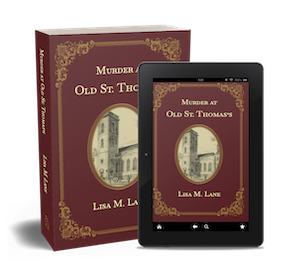Why has it been so long since my last post? Well, I’ll tell you. I decided to participate in NaNoWriMo.
 For the blessedly uninitiated, NaNoWriMo stands for National Novel Writing Month, and it’s always November. Since 1999, writers and would-be writers from all over the country, and now the world, try to write a novel of 50,000 words from scratch in one month. It’s a challenge, to be sure, and I wanted to see if I could do it just for the hell of it.
For the blessedly uninitiated, NaNoWriMo stands for National Novel Writing Month, and it’s always November. Since 1999, writers and would-be writers from all over the country, and now the world, try to write a novel of 50,000 words from scratch in one month. It’s a challenge, to be sure, and I wanted to see if I could do it just for the hell of it.
My typical Victorian mysteries simply cannot be done in a month because of all the research involved. And my workflow is such that just writing without stopping continually to research is impossible. But how about a different genre?
It occurred to me that romance is very popular, that no (or very little) research need be involved, and that if it came out well I could publish it somewhere I would never put my mysteries, such as Kindle Unlimited or Wattpad. I happen to have discovered that a colleague from our local chapter of the Historical Novel Society was thinking of doing the same thing, so we’re both doing it.
Yes, I said romance. No, I have never written romance before. I am concerned enough that I’m using a pen name: Lydia Greenwood.
For NaNo, the word count is everything. You write as fast and best as you can, but shouldn’t go back or edit much as you go, or you won’t make the word count. I made it harder (but more useful) for myself by making my goal 65,000 words instead, which is closer to novel-length. What makes it even more difficult is that I am what they call a “pantser” — even when I try to create an outline of the plot to guide me, I end up just writing off the cuff instead, having little idea where I’m going.
I did try to create an outline in the last week of October, following a romance template, but it was quickly abandoned.
NaNo writers can register at the central website, and there are many local groups that meet both online and at local places. You can have as much or as little support as you wish. I have several “buddies” at the site, but we only have time to contact each other occasionally, and I don’t need the pep talks provided. I did attend a great presentation by Hank Phillippi Ryan, sponsored by Sisters in Crime, on the “Muddle in the Middle” (that middle of the book where things can slow down and get draggy). Got a few ideas of how to add excitement.
I did some reading about how to write a romance, and have concluded that there are some other challenges with a mystery writer doing romance:
1. The tendency to start with a dead body
OK, yes, I do, but only because he’s died without a designated heir and that’s part of the romance. Nobody has been murdered — at least, so far.
2. The desire to have an underlying puzzle
I could not for the life of me figure out what two people could do while falling in love that would be remotely interesting to an outsider. But if they solve a mystery together — aha!
3. The feeling there must be an antagonist
I learned that the couple must experience not only the opportunity to be together, but obstacles throughout that make the relationship unlikely or tricky, which adds an element of suspense. In mysteries, this would be an antagonist trying to stop them. Yeah, he’s in there, not trying to stop them from falling in love, but from getting what they want.
4. The confusion of goals
Each main character is supposed to have a goal, so in a romance it should be a goal other than to fall in love and have a romance. See why I ended up with a mystery back story? They must both want something for which love would get in the way. Love is inconvenient when you’re trying to do something else.
5. The burden of not being a romantic
I’m not a romantic, although I’m certainly not averse to candlelight and chocolates (the latter being more important, of course). Love can make people unsure of themselves and too daring at the same time. They do things they’d never do, experiencing a transformation of self that may be overly attached to the other person’s actions. I prefer motives like jealousy, money, revenge, hatred. So it’s more difficult for me to understand my characters, even as they write their own stories.
So wish me luck. I’m at 41,316 words and have taken time out to write this post. What will happen next? Where has our hero disappeared to? Will my heroine get the help she needs to undo the entail on her grandfather’s house? Will she find the miniature? And how can my hero and heroine have a relationship if he lies like a carpet and she swears like a hostler?
Ask Lydia Greenwood.

















